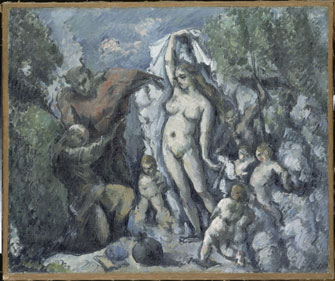Artworks for a
Depraved Imagination

“The Temptation of Saint Anthony” (1877). © RMN-Grand Palais (Musée d’Orsay)/Hervé Lewandowski
For generations following his death in 1814, Donatien Alphonse François de Sade, better known as the Marquis de Sade, was referred to only in hushed tones. His scandalous works were banned and his image vilified. Napoleon called Sade’s novel Justine “the most abominable book ever engendered by the most depraved imagination.” The writer’s outrageous life story included numerous spells in prison, including the Bastille. He ended his days in a lunatic asylum.
Starting in the 1940s, Sade’s dense, wide-ranging work began to be reinterpreted in a more positive light by psychologists, Surrealist artists and postmodernist intellectuals. Annie LeBrun, author of several works on the subject and one of the curators of the exhibition “Sade: Attaquer le Soleil” at the Musée d’Orsay, has chosen to illustrate the writer’s influence on art, cinema, popular culture, philosophy and psychoanalysis.
After passing through a darkened passage with video excerpts of Sade-inspired movies, the visitor arrives amid an array of all manner of artworks stimulated by ideas of desire, licentiousness and horror. Here we find Picasso’s “Le Viol” (1940), Henry Fuseli’s “Le Silence” (1799-1801) and Cézanne’s “La Femme Etranglée” (1875-76), as well as works by Auguste Rodin, Aubrey Beardsley, Honoré Daumier, Edvard Munch and others.
It is when we reach such photos by Man Ray as “Nu Attaché” (1930) that we begin to appreciate how sexuality, desire and impulsions to violent behavior are worth appraising on an intellectual level. Sade himself, who once declared that “no man should marry before having studied and dissected at least one woman,” was apparently fascinated by human anatomy and spent hours consulting the rather gruesome illustrated manuals that were available to the medical profession in the late 18th century, some of which are displayed in the exhibition (e.g., Des Parties Naturelles de la Femme, 1754).
The next part of the show includes varied examples of under-the-counter pornographic material from the early 19th century onward, with drawings of people in various types of sexual activity or satirical cartoons. It is interesting to note that Sade’s literary output coincided with the introduction of cheaper methods of mass printing, enabling his work and that of rival pornographers to be printed in different countries and widely distributed.
Nineteenth-century iconography shows how the prudish Victorians were in fact obsessed with eroticism. This was revealed in their taste in sculpture or painting of scenes from antiquity. The story of Salomé was a popular motif, but any ancient story or theme was fair game, particularly when it featured female nudity. Ingres’ “Dormeuse de Naples” (1809), Courbet’s “Le Sommeil” (1866) and Auguste Clésinger’s sculpture “Femme Piquée par un Serpent” (1847) are there to underline the point.
Display cases contain some of Sade’s original notebooks, in tiny handwriting. They prove to be of enigmatic interest, such as notes intended for his valet listing his “onanistic practices, including a key permitting how to understand them.”
In fact, Sade was an intellectual with far-reaching ideas that went well beyond the body and human sexual urges. He was an anti-militarist and campaigner against the death penalty, and, although an atheist, was fascinated with theological discourse and penned reams of theories and reflections on the subject. In an age when Rousseau, Descartes and Hobbes were affirming that nature, reason and virtue should rule humankind, Sade spent his life penning a contrary view.
The curator considered it appropriate to include such bizarre elements as Paris police photographs from 1880 showing “le tronc de femme dans une valise découverte dans la Seine” (“a woman’s torso found in a suitcase in the Seine”).
A fascinating program of talks, debates and movie screenings accompanies the exhibition, and the museum bookshop is a treasure trove of little-known printed, photographic and cinematic material on Sade and his œuvre.
Musée d’Orsay: 1, rue de la Légion d’Honneur, 75007 Paris. Métro: Solferino. RER: Musée d’Orsay. Tel.: 01 40 49 48 14. Open Tuesday-Sunday, 9:30 a.m.-6 p.m., until 9:45 p.m. on Thursday. Admission: €11. Through January 25, 2014. www.musee-orsay.fr
Click here to read all of this week’s new articles on the Paris Update home page.
Reader Reaction: Click here to respond to this article (your response may be published on this page and is subject to editing).
Support Paris Update by ordering books from Paris Update’s Amazon store at no extra cost. Click on your preferred Amazon location: U.K., France, U.S.
© 2014 Paris Update
Favorite